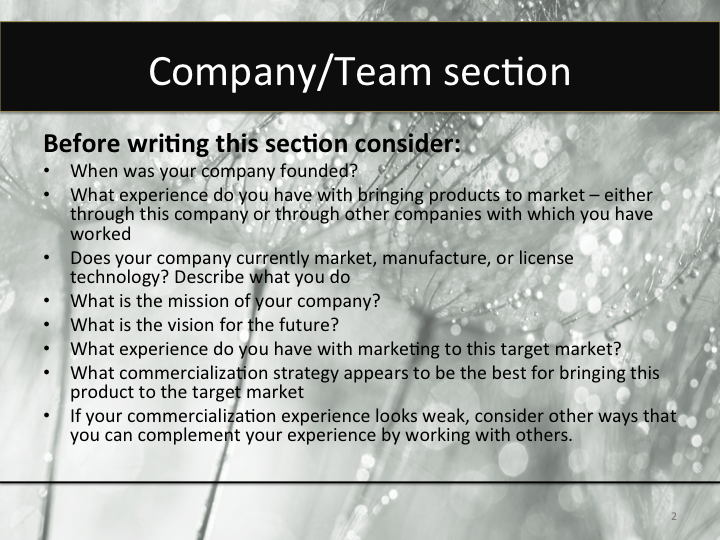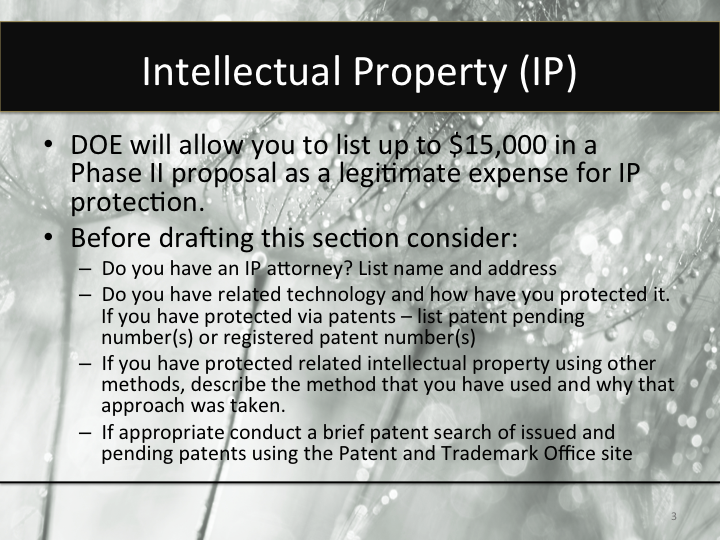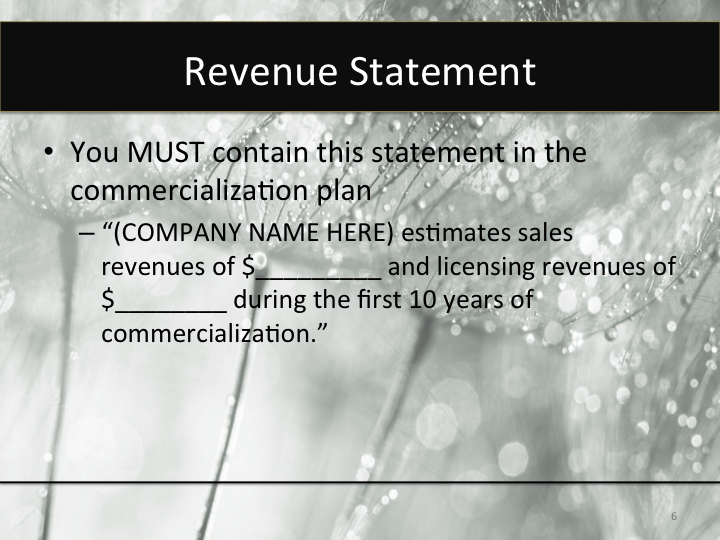Tutorial 21:
How do you write a good commercialization plan?
An essential part of your DOE Phase I application is the Phase I Commercialization Plan – please keep in mind that without it, your proposal will not be reviewed. The commercialization plan is a two page document that addresses the following four topics:
- Market Opportunity
- Intellectual Property
- Company /Team
- Revenue
Let’s begin by discussing why a Commercialization Plan is important and then explore how to develop a good commercialization plan.
When the Department of Energy makes an SBIR or STTR award, it is doing so with taxpayer money. The purpose for funding the research is to generate results that will have a positive societal benefit. This goal can only be met if the technology is successful and if it is commercialized, or brought to market. Most research and development firms have limited experience with commercialization. Therefore, commercialization planning will require consistent attention concurrent with the development of the technology. Incrementally, with additional rounds of funding DOE will require that the grantee provide more details on how they will engage others and/or change their company in order to successfully commercialize the technology – that is to bring the product to market. Let’s look at the four sections that you are going to write – starting with the sections that are easiest to address – but not in the sequence in which they will ultimately be presented in the commercialization plan.
I like to start with the Company/Team section. Before writing this section, articulate the following items, jotting them down in a word file.
After you have completed this activity, review the sample Commercialization Plan that DOE has provided on its web site under “Applicant and Awardee Resources” and review the company section. You will see that in the first paragraph they talk honestly about their experience with commercialization. In the second paragraph the commercialization strategy is articulated with a brief explanation provided. Finally in the last paragraph the individual that will be responsible for spearheading the commercialization activity is identified and the role that they will play clarified. Now that you have reviewed your situation and looked at the sample provided by DOE, draft a half page Company/Team section.
The next section to consider is the intellectual property or IP section. Begin by reviewing the intellectual property section in the example provided by DOE. You will see that the author shows evidence of having explored the patent literature. The author states what has been found, and then presents the IP strategy that the company will utilize to protect their intellectual property. It is important to consider that there are multiple ways to protect intellectual property. Although patents are often used to protect intellectual property – when it comes to software and algorithms it is more common to use a combination of copyright and trade secrets because of how rapidly things change. Be sure to consider what the appropriate forms of IP protection are for your intellectual property.
Sometimes companies present excuses as to why they are not protecting their IP via patents, when this is the appropriate course of action. Often the reason presented is lack of funds. Please keep in mind that DOE will allow you to list up to $15,000 in a Phase II proposal as a legitimate expense for IP protection. Also, keep in mind that if you plan to license your IP to another – intellectual property protection is very important.
Before drafting the Intellectual Property section, follow the same approach as you did with the company section. Jot down information regarding the following items in a Word document
After you have prepared your notes, draft the intellectual property section. A couple of important things to keep in mind (1) Don’t indicate that you have submitted a patent application if you haven’t. There’s a big difference between thinking about applying for a patent and actually doing it; (2) Don’t indicate that you have a patent pending or issued patent unless you can present an associated number; (3) Other forms of IP also have value: trade secrets, registered copyright, and trademarks.
The Market Opportunity section is much more difficult to draft, as it relies on gathering information from other sources. Please keep in mind that at Phase 0 you are asked to take an initial look at market opportunity. At this point you are taking a very quick, somewhat superficial look at the market opportunity. There are various ways that you can approach this challenge. First, the concept of market implies the potential number of entities that have problem X or could benefit from product Y. Market opportunity is expressed in dollars or units. For example, one could say that the market for X product is $500M over the next 10 years or that data available from X source indicates that Y organizations/ individuals have this problem annually. One could also say that industry experts expect a cost savings of $350M a year through the adoption of this new manufacturing method. Any of these are expressions of market opportunity. What is important to keep in mind is that market opportunity is not strictly for your product – but for a class of products and solutions that could be provided by you and all competitors. In other words, a market opportunity is NOT the same thing as your sales projection. If there is a need – then it is one that you and your competitors can all hypothetically fill.
So how do you find this information? Let’s build on the example that DOE provided of “battery separators for lithium ion batteries.” I’m going to go to Google and search in a very simple way using the phrase “market for battery separators”. Please review the accompanying demo to see how I went about finding information that provided the information that I needed.
Once I have found the needed information, I look again at the DOE example of the Commercialization plan and notice that in the first paragraph of the Market Opportunity section that the proposer clarified what their product was and discussed their competitive advantage. In the second paragraph the estimated size of the market opportunity was mentioned as well as those factors that were contributing to market growth. The company identified who their customers would be – i.e who would buy directly from them. Based on the value proposition identified for the targeted customer, an estimate was made of the market penetration that the company could achieve. Market penetration is the same thing as a sales projection, but represented as a % of the entire market. Here you have to use some judgment and perhaps refine your market if it is not reasonable to think that you can penetrate the global market using the strategy that you articulated at the outset.
This part of the planning process is most enjoyable because a quick search opens up a world of possibilities and enables one to quickly find information that can be used to develop one’s commercialization strategy. Now that you have gathered the information, draft the market section. Include three paragraph: (1) In the 1st paragraph, restate what the product is and discuss your competitive advantage. (2) In the second paragraph, name the market that you will be competing in – such as the “battery separator market for lithium ion batteries”, include an estimate of the size of the market opportunity and a brief discussion of those factors that are contributing to market growth. (3) In the third paragraph clarify who your customers will be and where you and they fall in the supply chain. Also include the names of some of the competitors in this market.
The last element of the commercialization plan is a Revenue Statement. This is frequently the hardest part of a Phase I commercialization plan to write – because at this point you may have very little upon which to base your projections. However, the reason this section is essential is that it forces you to think about whether or not there is a need and if, hypothetically you could have an impact on the economy using the strategy you have identified. How should you approach this when you have so little to go on? Let’s take a look at the following statement from DOE’s Funding Opportunity Announcement (FOA) that must be included in as part of your Phase I commercialization plan. Failure to include this one statement will disqualify your application from further evaluation at DOE.
You MUST contain this statement in the commercialization plan
The question becomes what numbers do you put in the blanks? Do you have to provide a substantiation for the numbers in this commercialization plan? and what if you are not going to use both strategies [direct sales and licensing] – then what do you do? Please see the accompanying demo to see how information can be found, again using Google to complete this section.
Now that you have considered all the information required to draft the commercialization plan and have written sections, please sequence them in the manner that DOE has requested.
Quiz: Tutorial 21: How do you write a good commercialization plan?
1
Which of the following is not one of the sections of the DOE Phase I Commercialization Plan Outline?
Nice Work
Try Again
2
How long should the DOE Phase I Commercialization Plan be?
Nice Work
Try Again
3
Which of the following is a true statement?
Nice Work
Try Again
4
True/False: It is best to sequence information in a commercialization plan in the way suggested in the FOA.
Nice Work
Try Again




